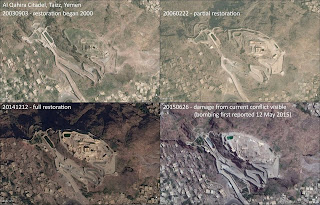Wednesday, April 13, 2016 -  Archaeology in Syria,DGAM,Palmyra,Syria
Archaeology in Syria,DGAM,Palmyra,Syria
 No comments
No comments
 Archaeology in Syria,DGAM,Palmyra,Syria
Archaeology in Syria,DGAM,Palmyra,Syria
 No comments
No comments
The Road to Recovery - DGAM in Syria Issues Initial Statement Regarding its Plans for Palmyra
Before undertaking any substantial rehabilitation project on the ancient city it is reassuring to know that the country’s heritage management authorities are carrying out a comprehensive damage assessment in order to document the nature and scale of all the damage before deciding on a measured and scientifically valid strategy for conservation and preservation.
As with any good heritage management plan, if there is any sense of urgency it will be to carry out any needed emergency repairs to stabilise the historic site and to minimise or prevent further damage while a long term comprehensive recovery plan is being considered and developed.
When reflecting on calls to restore Palmyra to its former glory, the internet has been abuzz with people arguing that it is too early to begin to think about heritage. While it is true that this conflict is sadly far from concluding, a peoples need to rebuild, to find normalcy where it is anything but, is not something that is date-stamped to begin solely once peace has been achieved.
Heritage damage in wartime is often symbolic of what has been lost. Likewise the yearning to restore emblematic monuments to their former glory can be symbolic of a citizenry's own desire to pick up the pieces of their own lives and put them back together.
In 1940 the German Luftwaffe attacked Coventry in the English Midlands and the city decided to rebuild its mediaeval cathedral the morning after its destruction. The Second World War also saw 85% of Warsaw's historic centre destroyed by Nazi troops and in 1946 the city initiated a 5 year campaign, (not without its detractors) carried out by its citizens, that resulted in a meticulous restoration of the city's Old Town, complete with recreated churches, palaces and marketplace.
For the Polish citizens of Warsaw who had lived through the horrors of war, the memory of how things were mattered more than authenticity.
Sometimes, the need to restore culture has does not even wait for reconstruction. In 1993 Zubin Mehta conducted the Sarajevo Symphony Orchestra and Chorus in Mozart's Requiem inside the crumbling ruins of Sarajevo's National Library, its music reminding us that sometimes food and shelter from the bombardment and strive are not the only things that heal woulds and knit a community back together.
If I could wish for anything, I would hope that local people, where appropriate, can be integrated into the rebuilding initiative as a means of healing for the fragmented community of Tadmur. Being part of restoring heritage together could help the citizens of the modern city begin their own recovery and would also mitigate the "history is more important than humanity" rhetoric that often comes with these types of heritage undertakings.
 |
| Director General of the DGAM has affirmed that the hypogeum of the Three Brothers, which dates back to 160 AD,in Palmyra stayed intact. |
Regardless of what projects are ultimately selected and acted upon, it is important that the conservation or reconstruction work be “de-politicised. Technical experts and conservators need to be able to get on with their work without pressure from political or other interest groups and so that they can focus on being sure that the heritage aid is integrated into a broader humanitarian recovery programme. In this way, and if handled delicately, reconstruction can be the first emotional bricks cementing a post-conflict reconciliation.
The people of Syria’s ability to recover from this conflict will owe much to their own cultural resilience, to people letting people get on with life on their own terms, and to not imposing our ideas onto their social and economic realities. By remembering that cultural heritage can be a positive tool for reconciliation and social reconstruction, whatever gets decided will assuredly take into consideration the sensitivities of the Syrian people and their need to reestablish the familiar as symbolic symbols of things returning to normal.
The ancient city of Palmyra as a monument is not merely a reflection of the ancient past. In a single desert location, Palmyra simultaneously tell us something about the country, the people who have for centuries populated the area, the city in all its former glory, and its many battles. Battles fought in wars long ago and battles fought which are still rawly fresh and indelibly carved into our collective psyche.
Palmyra is as much a reflection of society's ability to survive as it is a message of hope for Syria's future.
Op Ed - Lynda Albertson














